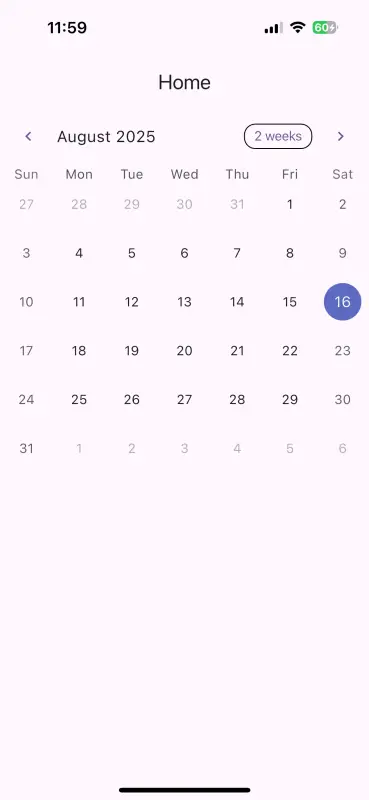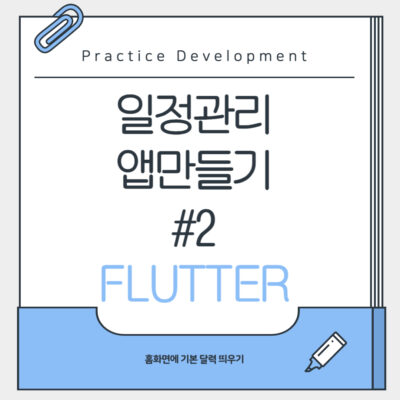이 전 글에 이어서 UI 개발을 진행해 보도록 하겠습니다.
우선 이번 스텝에서는 기본 달력을 띄워보는 것까지 기록해 보겠습니다.
주색상 선언
앱에서 사용할 주색상들을 선언할 파일을 만듭니다.
파일은 main.dart가 있는 lib 폴더를 기준으로 “lib/const/colors.dart”이라는 경로와 이름으로 만들겠습니다.
주색상은 초록색, 옅은 회색, 어두운 회색 그리고 텍스트 필드 배경색을 선언해 주겠습니다.
lib/const/colors.dart
import 'package:flutter/material.dart';
const Color primaryColor = Color(0xFF0DB2B2);
final Color lightGrayColor = Colors.grey[200]!;
final Color darkGrayColor = Colors.grey[600]!;
final Color textFieldFillColor = Colors.grey[300]!;
달력 구현
HomeScreen 화면 윗부분의 달력을 MainCalendar 클래스로 만듭니다. 달력은 ‘pubspec.yaml’에 추가한 table_calendar 플러그인을 사용합니다.
lib/component/main_calendar.dart
import 'package:flutter/material.dart';
import 'package:table_calendar/table_calendar.dart';
class MainCalendar extends StatelessWidget {
const MainCalendar({super.key});
@override
Widget build(BuildContext context) {
return TableCalendar(
focusedDay: DateTime.now(), // 현재 날짜
firstDay: DateTime.now().subtract(const Duration(days: 3650)), // 첫 번째 날짜
lastDay: DateTime.now().add(const Duration(days: 3650)), // 마지막 날짜
selectedDayPredicate: (DateTime day) {
final now = DateTime.now();
return DateTime(day.year, day.month, day.day) ==
DateTime(now.year, now.month, now.day);
},
onDaySelected: (DateTime selectedDay, DateTime focusedDay) {
// Handle day selection
},
onPageChanged: (focusedDay) {
// Handle page change
},
rangeSelectionMode: RangeSelectionMode.toggledOff,
onRangeSelected: (start, end, focusedDay) {
// Handle range selection
},
);
}
}
lib/screen/home_screen.dart
import 'package:flutter/material.dart';
import 'package:planner_example/component/main_calendar.dart';
class HomeScreen extends StatelessWidget {
const HomeScreen({super.key});
@override
Widget build(BuildContext context) {
return Scaffold(
appBar: AppBar(title: const Text('Home')),
body: SafeArea(
child: Column(
children: [
MainCalendar(),
],
),
),
);
}
}
lib/main.dart
import 'package:flutter/material.dart';
import 'package:planner_example/screen/home_screen.dart';
void main() {
runApp(const MyApp());
}
class MyApp extends StatelessWidget {
const MyApp({super.key});
// This widget is the root of your application.
@override
Widget build(BuildContext context) {
return MaterialApp(
debugShowCheckedModeBanner: false,
title: 'Flutter Demo',
theme: ThemeData(
// This is the theme of your application.
//
// TRY THIS: Try running your application with "flutter run". You'll see
// the application has a purple toolbar. Then, without quitting the app,
// try changing the seedColor in the colorScheme below to Colors.green
// and then invoke "hot reload" (save your changes or press the "hot
// reload" button in a Flutter-supported IDE, or press "r" if you used
// the command line to start the app).
//
// Notice that the counter didn't reset back to zero; the application
// state is not lost during the reload. To reset the state, use hot
// restart instead.
//
// This works for code too, not just values: Most code changes can be
// tested with just a hot reload.
colorScheme: ColorScheme.fromSeed(seedColor: Colors.deepPurple),
),
// home: const MyHomePage(title: 'Flutter Demo Home Page'),
home: const HomeScreen(),
);
}
}
실행화면

